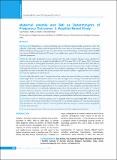Please use this identifier to cite or link to this item:
https://hdl.handle.net/20.500.14356/908| Title: | Maternal Anemia and BMI as Determinants of Pregnancy Outcomes: A Hospital-Based Study |
| Authors: | Koirala, Jaya Raddi, Sudha. A Dalal, Anita Dadi |
| Citation: | KoiralaJ., RaddiS. A., & DalalA. D. (2022). Maternal Anemia and BMI as Determinants of Pregnancy Outcomes: A Hospital-Based Study. Journal of Nepal Health Research Council, 20(02), 464-474. https://doi.org/10.33314/jnhrc.v20i02.4274 |
| Issue Date: | 2022 |
| Publisher: | Nepal Health Research Council |
| Keywords: | Anemia Body mass index Caesearn section delivery Low birth weight Preterm delivery |
| Series/Report no.: | April-June, 2022;4274 |
| Abstract: | Abstract Background: Malnutrition is a serious underlying cause of child and maternal deaths around the world. The objective of this study evaluates maternal anemia and body mass index as determinants of pregnancy outcomes. Undernourishment during pregnancy can occurs Intra Uterine Growth Retardation. Contributing to about 80,0000 new-borns, 40,0000 infant deaths and 20% under 2 years children have stunted, 20% of maternal deaths during labor and early postpartum. Methods: This study Hospital-based cross-sectional study. The study comprised laboring women admitted for delivery in selected tertiary care hospital in South India from 10th November 2021 to 20th January 2022. Structured interview schedule for demographic information, patient’s case sheet for information about the ‘Body Mass Index as a determinants of pregnancy outcomes’ and anthropometric measurement for body mass index (weight and height). All registered deliveries in the study period have been included, comprising of 101 sample size Bivariate logistic regressions were used to determine the factors associated with outcome variables. A significant level of 5% was used to decide the significance of statistical tests. Results: Body Mass Index in the 1st antenatal visit of the women who came for delivery in tertiary care hospital, underweight 36.6%, normal body mass index 52.5%, and overweight 10.9%. During 1st antenatal visit 58.4% had anemia, while 53.5% had mild anemia during the last antenatal visit. Respectively 39.6% of antenatal women had normal Hb% during 1st antenatal care visit, whereas 46.5% had normal Hb%, during their last antenatal visit. The mode of delivery; spontaneous vaginal delivery 45.5%, vacuum delivery 3.0%, emergency caesarean section delivery 50.5%. Preterm delivery was statistically significant among whose first antenatal care visit was after 11th weeks of gestation. Whereas, emergency caesarean section delivery was statistically significant among underweight. Increasing maternal weight body mass index was associated with maternal and neonatal health outcomes. Which was risk of pregnancy induced hypertension, preeclampsia, eclampsia, gestational diabetes mellitus and caesarean section delivery. Conclusions: Every 2nd women was anemic, every 3rd pregnant women was underweight (BMI >18.5), every 2nd baby was born with caesarean section delivery. Preterm delivery was statically significant of weeks of gestation during first antenatal care visit with more than 11th weeks of gestation. Whereas, emergency cesarean section was significant with low body mass index. Keywords: Anemia; body mass index; caesearn section delivery; low birth weight; preterm delivery |
| Description: | Original Article |
| URI: | http://103.69.126.140:8080/handle/20.500.14356/908 |
| ISSN: | Print ISSN: 1727-5482; Online ISSN: 1999-6217 |
| Appears in Collections: | Vol 20 No 02 Issue 55 April-June, 2022 |
Files in This Item:
| File | Description | Size | Format | |
|---|---|---|---|---|
| 4274-Manuscript-29700-1-10-20221103.pdf | Full Article. | 307.52 kB | Adobe PDF |  View/Open |
Items in DSpace are protected by copyright, with all rights reserved, unless otherwise indicated.
